

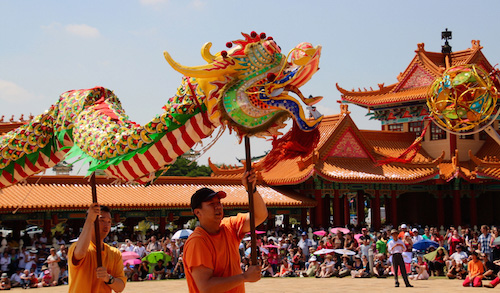
Tens of thousands of local South Africans and overseas Chinese appreciate a dragon dance in Nan Hua Temple on February 22, 2015. (Picture: People’s Daily Online / Zhang Jiexian)
The dragon dance is the most spectacular dance performed during the Chinese lunar New Year. Dragons, totems of the Chinese nation, are seen as friendly and helpful creatures associated with strength, good fortune, wisdom and longevity, which can make clouds and bring people rain. By performing the dragon dance, favourable weather will come and evil spirits will be driven away. Over 2,000 years, the dragon has turned from a symbol of a deity, the emperor and imperial power into a Chinese symbol. The dragon dance, accordingly, has been elevated from asking the gods for rain to expressing people’s courage, pride and wisdom.
The performers take coordinated and rhythmic steps and dance to the music of loud gongs and drums. The atmosphere is reinforced by the applause of the audience and the glimmering light. The dragon dance is impressive because of the magnificent scene it sets.
Drums, cymbals and gongs are parts of the dance. The drummer acts as a conductor and sets the rhythm for the other musicians to follow. As the drummer beats faster, the ensemble beats faster and louder. Drum-rolls and gongs may be heard from New Year’s Day until the 15th day of the first lunar month.
The dragon props are made into different forms, such as the cloth dragon, grass dragon, fire dragon, bamboo dragon, paper dragon and wooden stool dragon. The dance accordingly has diversified models and forms.
The longer the dragon, the more luck it will bring to the com- munity. As a result, communities strive to have very long dragon props during the New Year. Some dragons are so long that they require 20 to 30 people to hold them up.
The cloth dragon has a separate dragonhead and body, which are connected by cloth. One person uses a pearl-like prop to lead the dragon. The dragon will rise or fall, slowly or rapidly. Sometimes, it flies up to the sky, and sometimes it hides under the ocean and breaking waves.
The fire dragon is made with candles put into each section of its body. When performed at night, firecrackers will be set off. It makes an excellent scene of the fire dragon shuttling back and forth among the fireworks.
The grass dragon, also called the “burning incense dragon”, is made from rice straw and green vines, with sticks of burning incense inserted into it. Performed during summer nights, the dragon is like a meteor attracting a lot of insects. When the performance is over, the dragon is put into a pool to drown the insects. Therefore, performing with the grass dragon helps get rid of insects.
The Tongliang Dragon Dance, popular in TongliangCounty, Chongqing, was developed in the Ming Dynasty (1368- 1644) and was popular during the Qing Dynasty (1644-1911). It has two series: the dragon lantern dance and the coloured lantern dance, which have 10 and 12 types respectively.
The Human-Dragon Dance, popular on the Donghai Island, Zhanjiang, Guangdong province is renowned as the “one unsurpassed feat of the Orient”. The performers, consisting of several dozen to hundreds of young men wearing only shorts, make up a “gigantic dragon” with their half- naked bodies. It’s a grand scene when the human-dragon dances to the passionate and bright tempo of gongs and drums.
The local people invented the dance at the end of the Ming Dynasty to invigorate the frustrated Ming army who retreated to the Leizhou Peninsula. The dance was prevalent during the Qing Dynasty, blending various customs in the unique performance, such as entertaining the dragon, paying homage to the dragon, sacrificing to the sea, honouring the ancestors and worshiping the gods.
There is also the lion dance, a traditional dance performed on joyous festivals and big occasions. The dancers imitate a lion with various movements and actions, performed in a lion costume, accompanied by beating drums and gong instruments. It is believed the lion is an auspicious animal that brings good luck.
(The story was originally published on Business Day on January 29th, 2016.)
 Thai most beautiful transgender Nong Poy release new photos
Thai most beautiful transgender Nong Poy release new photos Now and then photos of Shanghai Jiaotong University
Now and then photos of Shanghai Jiaotong University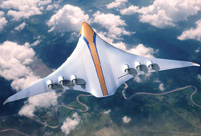 Is this what air travel will look like in 2050?
Is this what air travel will look like in 2050?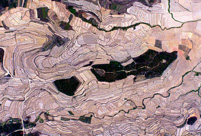 Aerial view of watermelon terraces in S China's Baise
Aerial view of watermelon terraces in S China's Baise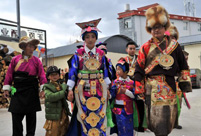 Traditional wedding of a post-80s Tibetan couple
Traditional wedding of a post-80s Tibetan couple Models in cheongsams present classical oriental beauty
Models in cheongsams present classical oriental beauty Second commissioned C28A corvette made by China enters Algerian Navy
Second commissioned C28A corvette made by China enters Algerian Navy Intoxicating Wuyuan in spring
Intoxicating Wuyuan in spring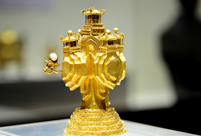 Gold and silver wares of Qing Dynasty exhibited in Shenyang Imperial Palace
Gold and silver wares of Qing Dynasty exhibited in Shenyang Imperial Palace Top 20 hottest women in the world in 2014
Top 20 hottest women in the world in 2014 Top 10 hardest languages to learn
Top 10 hardest languages to learn 10 Chinese female stars with most beautiful faces
10 Chinese female stars with most beautiful faces China’s Top 10 Unique Bridges, Highways and Roads
China’s Top 10 Unique Bridges, Highways and Roads Foreign investors to gain more access to China: minister
Foreign investors to gain more access to China: minister After two-child policy, sperm banks struggle to collect enough donations
After two-child policy, sperm banks struggle to collect enough donations Textbook piracy crackdown unlikely to work, greater awareness needed: experts
Textbook piracy crackdown unlikely to work, greater awareness needed: experts Overseas forces feed on disappearance cases to hype their rhetoric
Overseas forces feed on disappearance cases to hype their rhetoricDay|Week